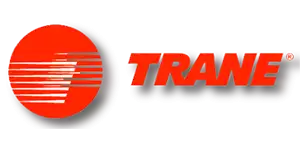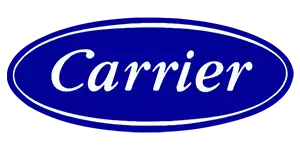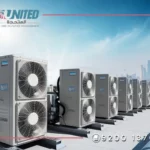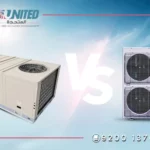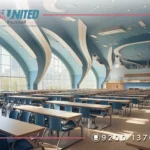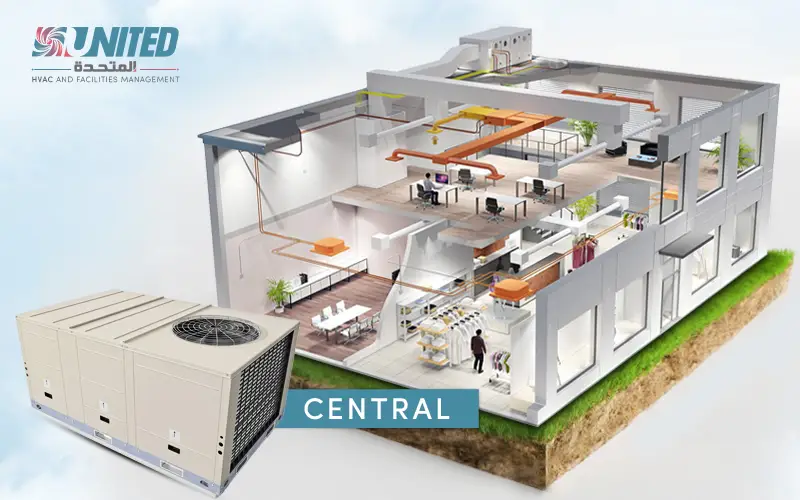
Central AC
Central air conditioning: more reliable cooling technology
Central air conditioning is one of the most common and widely used cooling systems in commercial buildings and large houses. This system is based on the effective distribution of cooled air throughout the building through a network of ducted extensions, providing a comfortable and convenient living and working environment.
1- What is central air conditioning
Central air conditioning is a single large-sized unit assembled for all parts of the air conditioning that cools the air and distributes it to various rooms and places in the building by means of ducting tracks in order to provide effective and uniform cooling of the building as a whole, instead of installing individual air conditioning units everywhere individually.
The central air conditioning unit is installed with roofs or bounces, it is used for large spaces for various sectors of projects “residential, commercial and government”
2- Components of central air conditioning!
- central air conditioning unit: includes all the central air conditioning parts of the “evaporator, compressor, expansion valve, condenser, fans and other cooling circuit accessories” and the central air conditioning unit is installed in a designated place outside the building on roofs or bounces.
- ducted duct extensions: the central air conditioning unit is supplied with two lines of tracks direct the first path is ” Supply "to transfer the cooled air from the central air conditioning unit to the various rooms and voids inside the building, the second path is called “Return" draws air from the rooms and voids and then connects it to the air mixing unit "Mix Box" which mixes the return air with a percentage of the outside air “Fresh Air " in order to replenish the air in the place and then return it again.
- dumber dispensers: are used to control the speed of air flow, quantity and distribution effectively and can be controlled manually or automatically and have several types.
- control unit: the control panel “thermostat” with central air conditioning allows temperature control, setting different temperatures for different rooms and places and adjusting the timing of system operation.
3- Advantages of central air conditioning!
- fresh air: the air is constantly renewed and purified from dust, odors and pollutants. Due to the presence of an air mixing unit, which mixes the return air with a percentage of the outside air.
- maintenance: all works Maintenance is carried out outside the building. There is no need for workers and technicians to enter the building.
- the most reliable: compared to other systems for large spaces, especially for commercial projects.
- easy control: central air conditioning allows setting the desired temperature in all different rooms by means of central control keys.
- good air distribution: central air conditioning helps to provide an even distribution of cooled air throughout the building, and due to the good design of the ducting paths.
- quiet: because the central air conditioning unit is outside the building and there are no internal parts that make sounds.
- better life span: due to the fact that all parts of the central air conditioning are assembled in one place and, of course, taking into account regular maintenance.
- energy-saving inverter technology: some companies have already started producing central air conditioning with this technology and it is available in Saudi Arabia
- aesthetic shape: preservation of decorations without distortion or breaks due to the absence of any internal parts of the central air conditioning except the DCT tracks.
4- Requirements for the installation of central air conditioning!
- study and design: this is the stage at which the appropriate thermal loads of the building are studied and calculated by specialized programs in the field, with the appropriate design of the “DCT” air distribution paths and the amount of air required for each vacuum, in order to avoid any noise or vibrations as a result of poor design and air distribution.
- architectural and construction requirements: openings in concrete ceilings must be taken into account before casting works, namely vertical openings intended for the passage of the DCT tracks from top to bottom, depending on the design, as well as openings in the walls for the passage of horizontal tamping and making sure that they do not conflict with fallen bridges.
- central air conditioning location: needs space on the roofs allocated with concrete bases to install the unit on them or with rebounds depending on the design and type of project.
- Power Line: customize High Power Line (3 won)
- ceiling height: the ducting tracks of the central air conditioning occupy a ceiling space ranging from (30 cm to 50 cm) and then gypsum works, which also occupy approximately (10 cm), the ceiling height must be taken into account that at least (3.50 m) approximately, to accommodate all heights
5- Stages of installation of central air conditioning!
The installation of central air conditioning is related to the various stages of construction, so there must be constant coordination between the air conditioning engineer and the engineer or supervisor specialized in each construction stage.
After the completion of the design of the executive plans of the central air conditioning, which specifically shows the locations of the central air conditioning units, the vertical and horizontal tracks and the places of the grills, and after the adoption of the plan, the following stages are started:
- Wooden boxes coated with a moisture-insulating material are made and placed in the specified places according to the scheme shown with vertical and horizontal roller tracks, before pouring concrete for the ceilings.
- The dactyl is suspended on suspenders made of iron corners painted with anti-rust material and taking into account the thickness, quality and interstitial distances.
- After the installation of the dactyl on the suspenders is completed, the parts of the dactyl are assembled together and this process is called the combination method.
- Then the joints of the sheet are sealed together by placing an iron paste on the places of connection between the cans in order to prevent any air leakage from the sheet.
- After the completion of the previous stages, the thermal insulator is glued to the die.
- The outer sheet of the central air conditioner exposed to direct sunlight is insulated with glass wool with a density (48kg) and a thickness (2inch).
- The internal Dactyl is insulated with insulators of thickness (1inch) and density (24kg).
- The central air conditioning unit is installed on the concrete bases assigned to it and rubber bases or cists are placed between the concrete bases and the air conditioning unit to absorb the vibrations generated by the central air conditioning unit.
- Connecting the feeder power cables of the central air conditioning with special flexible connections to absorb vibrations and noise.
- The “thermostat” control unit is installed preferably in close proximity to the “Return” return air filters to read the actual temperatures.
6- Central air conditioning applications
- Commercial buildings: central air conditioning is widely used in commercial buildings such as offices, malls, restaurants, hotels, mosques.
- Medical facilities: central air conditioning is used in hospitals and medical clinics to provide a comfortable environment for patients and workers.
- Industrial facilities: it is used in factories and warehouses designed to maintain a stable temperature and suitable storage conditions for sensitive materials.
- Residential buildings: it is also used in” villas and palaces " for large spaces and some customers prefer it, since its maintenance work is carried out outside the building.
7- Important points about central air conditioning
Due to the connection of the installation of central air conditioning with several accessories and accessories that work on the integration and effectiveness of the cooling process, without touching on the central air conditioning brand, where all brands share one way of working the system.
The quality of materials and accessories must be maintained at the beginning of the work: –
- ducting: ducting air ducts “ducting” is an important and complementary part of HVAC systems.the appropriate type of sheet with the required quality, the appropriate thickness and the design of dimensions and diameters must be selected accurately in order to avoid any subsequent problems.
- insulation: the DCT tracks are insulated with Fiberglass Glass Wool so that the Air maintains the temperature without losing it while passing the DCT, the appropriate type of insulation must be selected with the required density،
At least the thickness (1 inch) and density (24kg) of the inner ring،
The thickness (2 inches) and density (48 kg) of the outer layer exposed to the direct sun, and a layer of fabric and glue is also made or covered with cladding.
Sound insulation is also made with a thickness of (1 inch) and a density of (24 kg) extended from the central air conditioning unit to the interior of the building at a distance of (3 to 6 meters) to reduce the sound level of air rushing from the fans.
- dispensers Hopper”Dumber”: controls the speed of air flow, its quantity and distribution effectively must be distributed well to ensure the proper amount of air for vacuum and installation of types customized by type of project such as fire (fire) dampers) or automatic types (Vav) variable air volume, which have a gate that opens automatically for the passage of the required amount of air through the control device.
8- Choose the right system!
When choosing a central air conditioning system, many factors should be taken into account, such as the size of the building, its planned use, financial cost and personal comfort goals. It's good to consult us to help make the right decision.
We always strive to provide unique solutions and services tailored to the needs of our customers, to start our journey from where others ended to offer our customers " innovative solutions.... For an easier life
Don't hesitate to request a quote, or any inquiry about the central air conditioning system or any other air conditioning system, our engineers are waiting for your request, and help you. Just click on the “Contact Us " button, or talk to our engineer via WhatsApp




